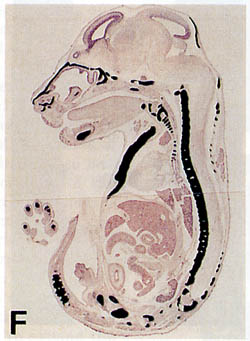|
|
|
|
| | |
| | |
|
|
|
|
| | |
|
|  |
| |
|
|  |
|
 |
|
| Gene expression of type II collagen in a 16.5 d.p.c. mouse embryo |
|
| The
lab members are involved in teaching Molecular Biology, Cell Biology,
Biochemistry and related subjects for the students in the Faculty of
Medicine.
| Medical students |
: | Introductory course II, Tutorial course 2 (Biochemistry) and related tutorial course, and Experimental course.
|
|
| |
|
| Nursing students |
: | Biochemistry course |
| | | |
| Masters course |
: | Basic Life Science course |
| | | |
| Doctor course |
: | Matrix Biology course |
|
| |
|  |
| Living
organisms consist of numerous different types of cells. The cells must
be hierarchically organized into tissues, organs and organs systems. In
order to function as an organism, the extracellular matrix surrounds
the cells and functions as the architecture of the body, such as in
bone, cartilage skin and so on. However, recent advances in the fields
of molecular biology, cell biology, and developmental biology have
shown that the molecules in the extracellular matrix are actively
involved in cell adhesion, proliferation, differentiation, induction
and inhibition of angiogenesis. The goal of our research is to
understand the roles of the molecules in the extracellular matrix,
especially collagen.
| The main projects are; | | 1) |
Transcriptional regulation of collagen genes | | 2) | Elucidating the function of collagen molecules and their derived peptides | | 3) | Basic research for elucidating the mechanism of fibrosis and its application for therapy |
|
|
| | |
|
| | |
|
| | |
| | | |
| | | |
 | | |
|
|
|
|
| | |
|